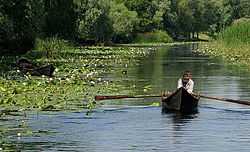Lipovans

Lipovans or Lippovans (Romanian: Lipoveni, Ukrainian: Липовани, Russian: Липовáне, Bulgarian: липованци) are Old Believers, mostly of Russian ethnic origin, who settled in the Moldavian Principality, in Dobruja and Eastern Muntenia. According to the 2002 Romanian census there are a total of 35,791 Lipovans in Romania, of whom 21,623 living in Dobruja.
Name
The name has been suggested to be related to Slavic Липа (lipa), linden tree or to Filippovka, a holiday name dedicated to Saint Philip. However, the accepted etymology is that it's derived from Filipp Pustosviat (1672–1742), leader of the group which emigrated to what is now Romania. The adherents were thus referred to as Filippoveni," abbreviated to Lipoveni. [1]
History
They emigrated from Russia in the 18th century, dissenters from the mainline Russian Orthodox Church. They settled along the Prut River in Moldavia and in the Danube Delta. They have maintained strong religious traditions that predate the reforms of the Russian Orthodox Church undertaken during the reign of Patriarch Nikon. When he made changes to worship in 1652, part of the believers carried on worshipping in the "old way". In that sense, they continued to speak Old Russian, to cross themselves with two fingers instead of three, and to keep their beards. The Russian government and the Orthodox Church persecuted them and as a result some committed suicide by burning themselves, with many other being forced to emigrate.
In 1876, the Lipovans were joined by some Skoptsy sect members who emigrated to Romania to escape prosecution.
Lipovans were considered to be schismatic by the Russian Orthodox Church, though relations have improved recently; see the main article on Old Believers.
Population

The main centre of Lipovan community in Ukraine is Vilkovo. The town has its own church, St Nicholas. In order to construct their homes, the Lipovans create islets of dry land by digging mud out from trenches and put into work a series of canals. The house walls are made of reed and mud,[2][3] and thatching is standard for the roofing. Because of the characteristics of these materials, the buildings have a tendency to sink into the mud and need to be rebuilt every few years.
For details on the Lipovans in Bulgaria, see Russians in Bulgaria.
See also
References
- ↑ Victor Vascenco, "Melchisedec şi lipovenii", Romanoslavica (University of Bucharest), XLII, p. 133
- ↑ "Water world". The Independent (London). 2005-06-18. Retrieved 2010-05-07.
- ↑ "The Danube". Archived from the original on 2006-05-04.
External links
- Second-Hand Souls: Selected Writing by Nichita Danilov (translated from Romanian by Sean Cotter)
- Lipovan's icons: The Bleschunov Municipal Museum of Personal Collections
- Romania. Religious Freedom Report 1999
- Zorile newspaper published in Romanian and Russian
| |||||||||||||||||||||
| ||||||||||||||||||||||||||||||||||||||||||||||||||||||||||